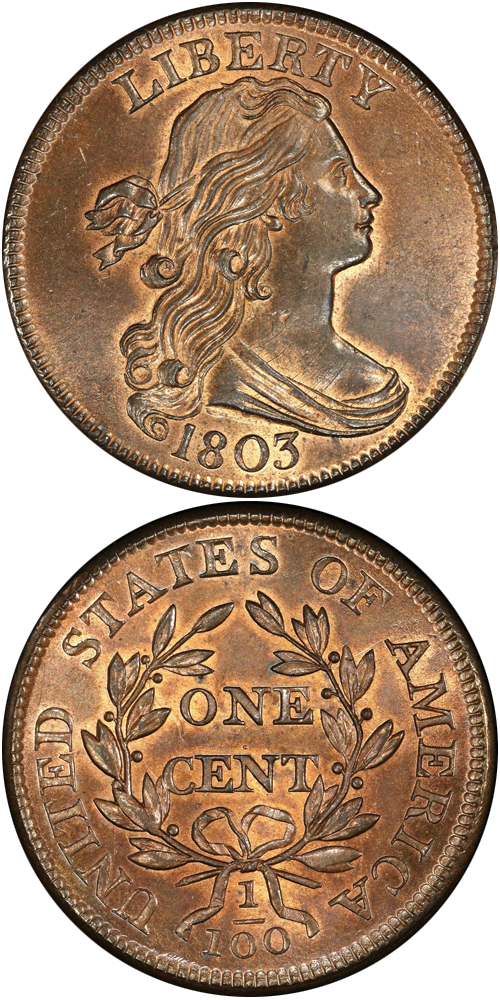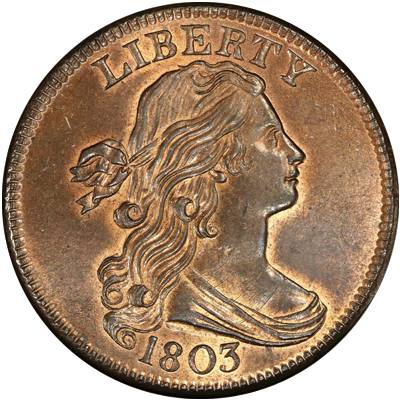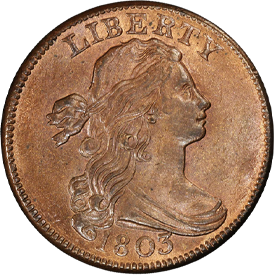Designed by: Robert Scot
Issue Dates: 1796-1807
Composition: Copper
Diameter: 29 mm
Weight: 10.88 grams (168 grains)
Edge: Plain
Business Strike Mintage: 16,111,810
Proof Mintage: None
In the cent series the Draped Bust obverse appeared in 1796 (the year after it made its initial appearance in American coinage on the 1795 silver dollar). Patterned after a proposal of artist Gilbert Stuart, and translated into the coinage medium by Robert Scot, the style features Miss Liberty with flowing hair, a ribbon behind her head, and drapery covering her plunging neckline. LIBERTY is above, and the date is below. The reverse is similar to the preceding design and consists of an open wreath enclosing ONE CENT with UNITED STATES OF AMERICA and the fraction 1/100 surrounding. Denticles are around the border, although on some varieties they are not particularly well defined.
Many different die varieties were made within this span. The numismatist seeking something different can find an example from a blundered die, such as with the incorrect fraction 1/000, at little extra cost. Among Draped Bust cents, rare dates are 1799 and 1804. Other issues are seen with frequency. Examples are readily available in all grades from Fair through Extremely Fine, with AU coins being rare and Uncirculated pieces being extremely rare.
Further Reading
This style features the draped matronly (as some have suggested) bust of Miss Liberty facing to the right, as designed by Gilbert Stuart for initial use on the 1795 silver dollar. During the early years of the American coinage spectrum, it was the practice to use the same design on many different denominations. Thus, the Draped Bust is found on the half cent, half dime, dime, quarter, and half dollar in addition to the cent and silver dollar.
In keeping with progress, examples of the Draped Bust style became increasingly similar as the years went on. However, enough die-cutting errors exist to satisfy the curious. One of the most interesting is the so-called LIHERTY variety of 1796. The letter B of LIBERTY was first cut facing the wrong way, and then it was recut in the proper position. The result of this double punching appears as an H letter, hence the name for the issue.
A number of minor reverse variations exist among cents of 1796. These can be grouped into several categories. The Reverse of 1794 has a double leaf at the top right, 14 to 16 leaves on the left part of the wreath and 16 to 18 leaves to the right. The Reverse of 1796 has a single leaf to each side of the wreath apex, 17 to 21 leaves to the left, and 16 to 20 leaves to the right. The Reverse of 1797 has a double leaf at the top right, 16 leaves to the left, and 19 leaves to the right.
It has been my experience that collectors of cents can be divided into three categories. First, there are those who collect them as part of a type set of United States coins. Such numismatists desire but a single example of the Draped Bust style, to use the present example, and it can be of any date from 1796 through 1807, the cheaper the better. The second type of collector desires one of each cent date, plus major or interesting varieties. Such a collector would probably either have just a single 1796 cent or a pair of 1796 cents (a regular one plus the LIHERTY error). The third type of collector is the die variety specialist who, using Penny Whimsy, is concerned with the reverse styles of 1794, 1796, and 1797 as well as other die differences.
The definition of one's collection is important to consider at the outset. While no collector I have ever known jumps into the numismatic arena with a life collecting plan all mapped out, for experience always suggests change, it is advisable to "read the road map before taking the trip." To this extent I recommend buying a copy of Penny Whimsy. You may not decide to collect by die varieties, or even by date and major variety sequence, but the discipline and philosophy of large cent collecting, so eloquently outlined in Dr. Sheldon's work, are worth knowing and can be applied to any other area of numismatics as well.
Cents of 1797 and 1798 follow the general design of 1796. A variety is provided by the 1798/7, the first overdate to occur in the large cent series.
Cents of the year 1799 have always been famous, representing as they do the rarest date in the large cent series. Years ago, 1799 cents were classic rarities in an era when most other coins had lower values. The appearance of a top grade 1799 cent has always been a numismatic event. Dr. Sheldon, who sprinkled his book with many anecdotes, personal observations, and even witticisms, parenthetically noted of the 1799:
"Second in fun only to the practice of selling genuine 1799s to collectors at high prices, is that of selling altered date, mutilated, or fake 1799s, of which there are a large number in numismatic circulation, and among these are a few masterpieces..."
Indeed, altering other large cent dates, particularly 1798 to "1799," seems to have been an important occupation of certain nineteenth century collectors, for I have seen dozens of such pieces over the years. When buying a 1799 large cent always check it out with the Penny Whimsy reference to be sure that all characteristics of the date, letter positions, and other features are correct.
There are two main varieties of this date-the 1799 /8 overdate and the 1799 "normal date." Both are quite rare in comparison to later-dated coins. The finest known 1799 cent is the AU coin known as the Hines specimen, named for one of its early owners, Henry Hines.
Cents of the year 1800 continue the Draped Bust design. Although there are numerous minor die differences, the year contains no popular errors or major varieties.
The following year, 1801, is different. Several die-cutting errors exist, the most interesting of which is the famed Three Errors Reverse. This issue displays three egregious blunders: the fraction, which should have been written as 1/100, is written as 1/000 (which is completely meaningless from a mathematical viewpoint); one side of the wreath has a stem, but for some reason the stem was omitted from the other side; and, finally, the word UNITED appears as IINITED.
Among other interesting 1801 varieties is the Corrected Fraction issue. The fraction was first engraved as the mathematically meaningless 1/000 and then was corrected to 1/100, with the incorrect 0 still prominently showing under the 1. The same error occurs on an 1803 cent variety.
The year 1802 likewise has several interesting varieties, one of which is a "Three Errors" issue of a sort. This particular 1802 has both stems missing from the wreath, two fraction bars instead of one, and the S in STATES sharply doubled. The same reverse was also combined with an 1803 obverse, so the 'Three Errors" variety can be collected for that date as well.
The year 1803 has several varieties that have been popular with collectors over the years: small date, small fraction; small date, large fraction; large date, small fraction; large date, large fraction; stemless wreath; and the 1/100 over 1/000.
In general, cents of the years 1800 through 1803 are available in all grades from About Good through Uncirculated. The type set or date collector will have no difficulty locating Fine, Very Fine, or Extremely Fine examples. Higher grade specimens are elusive.
Cents of 1804 are the most desired among nineteenth-century large cent issues. Specimens of this year are scarce, and pieces in higher grades can be considered rare. Just one pair of dies was used to produce original 1804 cents. During use the obverse and reverse dies became broken on the rim.
While many 1804 cents have smooth light brown surfaces, a good number of them are deep brown or black and show porosity, evidently as a result of the characteristics of the particular copper supply used. Together with the three different major varieties of 1793 and the 1799, the 1804 cent has been admired as a top rarity by collectors ever since cents became popular to study. The total population of 1804 cents is not known, but a number somewhere in the hundreds would probably be a good guess, possibly even a quantity approaching one thousand. Dr. Sheldon notes that only two Uncirculated pieces can be accounted for, and these each barely make the Mint State classification. He further estimates that as many as 30 grade Very Fine or better. The vast majority of pieces are in lower conditions, from Good through Fine and, as noted, often with porosity.
An interesting variety of the 1804 cent was made around the year 1860. Known as the "restrike," the piece should more properly be termed a creation, for a restrike implies a later issue of something that was earlier produced. In the present instance, the die combination used to make the 1804 restrike was never employed for circulating coinage.
The obverse die, dated 1804, was crafted by altering an 1803 cent die. The reverse die was originally used on a cent of 1820 and is stylistically much different from that used on an original 1804 (the 1820 reverse has a continuous wreath without an opening at the top, whereas the 1804 wreath is open).
Although not much is known about the actual circumstances surrounding the issue of this famous "restrike," it probably was produced from dies sold as "scrap iron" by the United States Mint during the 1850s. For a number of years this piece was catalogued as the "Mint Restrike," for specimens evidently were first sold by employees at the Philadelphia Mint, or perhaps they emanated from private sources in the same city. Considering the rusted state of the dies and also the surface similarities of the 1804 issue to other restrikes from discarded dies (such as the 1811 restrike half cent with reverse of 1802, and the 1827 restrike quarter) it seems doubtful that this venerable minting institution was indeed the source. Such a production would have been a cause of embarrassment and would have directed unfavorable attention to Mint activities (as it was, the Mint was indeed producing restrikes, but care was taken to use dies that were excellently preserved, not rusted!)
Dr. Sheldon quotes an earlier comment concerning the piece, reflecting the Mint origin believed by some: "This singular example of the low moral tone of some of our public officials made its appearance about the year 1860. It is in no real sense a restrike but was manufactured for the sole purpose of supplying coin dealers with a cent they could sell to young and ignorant collectors." The gross mismatching of obverse and reverse dies, plus the crude appearance of the piece, produced an issue which would fool few numismatists, even "young and ignorant collectors." Today the 1804 "restrike" is avidly collected as an interesting curiosity of the period. The typical piece is light brown in appearance, often with suggestions of original red coloration.
The Draped Bust design was continued through 1805, 1806, and 1807. The best-known scarce issue in this range is the 1807 overdate variety with small 7 over 6, blunt 1 in date. Only a few dozen specimens exist. By contrast, the 1807 overdate with large 7 over 6, pointed 1 in date, is relatively common. Also scarce within this era are cents of the year 1806.
What constitutes a major variety and what doesn't, what should be collected and what shouldn't, is strictly a matter of personal opinion – in the realm of one's views on whether or not anchovies are proper addition to pizza! In general, the presence of a die break on a coin forms an interesting aspect of a given issue but does not constitute a variety to be collected separately. "Every rule has its exceptions" is an old saying, and in numismatics this is quite true. Such an exception is provided by the 1807 Comet variety, which consists of a normal 1807 obverse which has a comet-like die flaw or break behind Miss Liberty's hair, as if she is about to be attacked by it. Doubtless, had the die break been in another location collectors would have paid it scant notice. However, the fanciful resemblance to a comet fascinated col lectors beginning over a century ago, and the Comet variety has been a mainstay of the cent series ever since. Around the middle of the nineteenth century comets were objects of admiration and awe. They were variously said to portend good luck or evil. Indeed, the Great Plague which devastated London during the 1660s was attributed to the passing of a comet! In 1858 Donati's Comet thrilled the world, and it may have been shortly after that time that the Comet variety received its name.
Later cents of the Draped Bust type, 1805 through 1807, are available in all grades from worn nearly smooth (Fair) to Uncirculated. In general, the surfaces are smooth and pleasing, without porosity, with colors ranging from reddish brown to nearly black. Uncirculated pieces are rarities, and AU coins are elusive.








